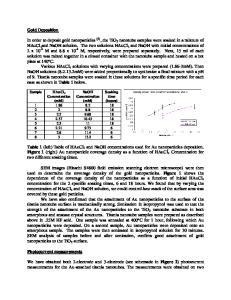Carbon-doped titania as a precursor for titanate nanotubes
- PDF / 840,483 Bytes
- 13 Pages / 584.957 x 782.986 pts Page_size
- 69 Downloads / 287 Views
Kai Herbst Department of Materials Engineering, Technische Hochschule Nuremberg Georg Simon Ohm, Nuremberg D-90489, Germany
Jewgeni Roudenko Department of Materials Engineering, Technische Hochschule Nuremberg Georg Simon Ohm, Nuremberg D-90489, Germany; and Institute for Chemistry, Materials and Product Development OHM-CMP, Technische Hochschule Nuremberg Georg Simon Ohm, Nuremberg D-90489, Germany
Jens Helbig Institute for Chemistry, Materials and Product Development OHM-CMP, Technische Hochschule Nuremberg Georg Simon Ohm, Nuremberg D-90489, Germany
Bastian Barton and Ute Kolb Institute of Inorganic Chemistry and Analytical Chemistry, Johannes Gutenberg University Mainz, Mainz D-55128, Germany (Received 1 October 2017; accepted 16 February 2018)
Carbon-doped titania was fabricated via carbothermal treatment in nitrogen–acetylene gas flow and further used as a precursor for multiwalled titanate nanotube (TNT) synthesis via alkaline hydrothermal route. Investigation of the reaction products after hydrothermal treatment of carbon-doped titania using Transmission electron microscopy, X-ray diffraction, and Brunauer– Emmett–Teller method shows the successful formation of TNTs. The presence of carbon was proved although the type of incorporation could not be certified. All samples show approximately the same carbon content before and after hydrothermal treatment. An increasing pretreatment temperature of titania precursor powders yields more secondary products in the nanotube samples, indicating lower reactivity of the titanium oxycarbide phase during hydrothermal treatment. In this study, TNTs with 6 wt% carbon and with the highest specific surface area of 340 m2/g were formed via hydrothermal treatment of carbon-doped titania precursor powder exposed to 700 °C during carbothermal pretreatment.
I. INTRODUCTION
Nanotube structures are known for various materials including titanium oxide. Tubular titanium oxide-based nanostructures are interesting for many applications such as energy storage and conversion, photocatalysis, and hydrogen storage. Their dominant characteristic is the high specific surface area. Depending on the application, the material can be modified enabling electrical conductivity or catalytic activity.1–6 Two methods for the fabrication of titanium oxide-based nanotubes are described in the literature: anodic oxidation and hydrothermal treatment. Anodic oxidation7 yields single-walled titania nanotubes which form highly ordered arrays. Metallic titanium foils are oxidized in a two-electrode arrangement at constant potential at room temperature. Ethylene glycol containing NH4F a)
Address all correspondence to this author. e-mail: [email protected] DOI: 10.1557/jmr.2018.49
and H2O is used as electrolyte, and typical voltages during anodic oxidation are 40–60 V. The anodization process leads to tubular structures with diameters of about 100 nm, which are oriented perpendicular to the surface of the titanium foil. The specific surface area thus obtained is about 40 m2/g. Due to the oriented ar
Data Loading...











